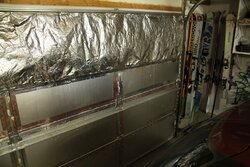Rather than derailing another thread [1], I'm posting separately on R-value calculations on garage doors here, thinking it might be of interest to several readers. I had taken a few basic equations provided by woodgeek, and applied them to a few different garage doors I was considering. Total surface area is 140 sq.ft., for two 9.5 x 7.25 foot doors.
Doors under consideration are urethane-foamed steel panel doors (typ.R16), styrene insulated PVC frame and panel doors (typ.R9), styrene insulated wood overlay doors (typ.R4), and uninsulated wood frame and panel doors (typ.R1).
This is for a shop, where I'll have auto change-over thermostat's set to 55F or 60F heat and maybe 85F or 90F cool, the primary goal being keeping things dry and preserving paints and chemicals. Thus, I plotted heating and cooling based on our local (SE PA) HDD's and CDD's, with heating base temperature = 55F and cooling base temperature = 85F:

The cost (Dollars/year) was derived using my proposed cooling system's HSPF = 10 and SEER = 20.5 (conservative, given temps I will be running), and our net PECO billing of $16.75/kWh.
I was trying to determine if the much more cosmetically appealing PVC frame and panel door (R9) was going to cost me enormously in heating and cooling, versus a more efficient (but less attractive) urethane on steel panel door (R16). The total cost difference PER YEAR was only $8, and in fact I could even go down to a wood overlay door (R4) with a penalty of only $32/year. The radiation penalty for going to a lower R-value on a pair of garage doors, given how I plan to heat and cool, is surely way below the dollars that will be lost to drafty door seals.
Knowing someone might have a problem with my chosen base temps, I also re-did this using more typical base temps for heating and cooling a house (65F / 80F). This might be of interest to those who finish a garage as a spare den or exercise room, and keep it heated closer to house temps:

As woodgeek had already stated qualitatively in the other thread, increasing R-values yield diminishing return. The difference between R1 (uninsulated wood frame and panel door) and R9 (PVC/styrene frame and panel door) is enormous, at $250 per year, but the difference between R9 and R16 is not that significant.
[1] - https://www.hearth.com/talk/threads/insulation-calculations.136769/page-2#post-1861889
Doors under consideration are urethane-foamed steel panel doors (typ.R16), styrene insulated PVC frame and panel doors (typ.R9), styrene insulated wood overlay doors (typ.R4), and uninsulated wood frame and panel doors (typ.R1).
This is for a shop, where I'll have auto change-over thermostat's set to 55F or 60F heat and maybe 85F or 90F cool, the primary goal being keeping things dry and preserving paints and chemicals. Thus, I plotted heating and cooling based on our local (SE PA) HDD's and CDD's, with heating base temperature = 55F and cooling base temperature = 85F:
The cost (Dollars/year) was derived using my proposed cooling system's HSPF = 10 and SEER = 20.5 (conservative, given temps I will be running), and our net PECO billing of $16.75/kWh.
I was trying to determine if the much more cosmetically appealing PVC frame and panel door (R9) was going to cost me enormously in heating and cooling, versus a more efficient (but less attractive) urethane on steel panel door (R16). The total cost difference PER YEAR was only $8, and in fact I could even go down to a wood overlay door (R4) with a penalty of only $32/year. The radiation penalty for going to a lower R-value on a pair of garage doors, given how I plan to heat and cool, is surely way below the dollars that will be lost to drafty door seals.
Knowing someone might have a problem with my chosen base temps, I also re-did this using more typical base temps for heating and cooling a house (65F / 80F). This might be of interest to those who finish a garage as a spare den or exercise room, and keep it heated closer to house temps:
As woodgeek had already stated qualitatively in the other thread, increasing R-values yield diminishing return. The difference between R1 (uninsulated wood frame and panel door) and R9 (PVC/styrene frame and panel door) is enormous, at $250 per year, but the difference between R9 and R16 is not that significant.
[1] - https://www.hearth.com/talk/threads/insulation-calculations.136769/page-2#post-1861889


